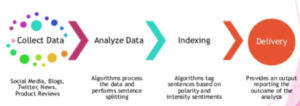Objective
One of the leading mobile provider wanted to monitor tweets to find out how their customers felt about their new release of the product features
Approach
We extracted tweets from twitter and these extracted tweets further pre processed as mentioned below
Tokenization: Split the text into sentences and the sentences into words. Lowercase the words and removed punctuation. Words that have fewer than 3 characters and all stop words were removed.
Lemmatisation : Words were lemmatized, i.e., words in third person are changed to first person and verbs in past and future tenses are changed into present.
Stemming: Words were stemmed, i.e. words are reduced to their root form.
TF-IdF approach was then used to convert the cleaned text into features.
Modeling
A polarity based lexicon(VADER lexicon) method was applied on the cleaned data and identified sentiment was scored based on the polarity score .

Impact
This algorithm quickly notifies the negative tweets.This allows for quick course of action to be undertaken for immediate redressal of the issue.



